
|   |

|   |
 e-mail: sunilkothari1933@gmail.com Nritya Parva 2018 Photos courtesy: Anjali Merh Memorial Trust February 24, 2018 The three day Nritya Parva 2018 was held at CC Mehta Hall, Baroda with performances by young dancers. The two day morning seminar was on Literature and Dance on first morning and on other topics the next morning. Parul Shah, disciple of late Anjali Merh and former Professor at Faculty of Performing Arts at MS University, has been arranging this festival at Baroda in Anjali Merh's memory. The whole Nritya Parva 2018 is organised by Anjali Memorial Committee, Baroda, every year since 1981. The name to the festival was coined about 10 years before. This year the festival was dedicated to the memory of late Shanta Serbjeet Singh, senior cultural commentator and former Vice Chairman of Sangeet Natak Akademi. In the formal invitation there is an interesting quote of Shanta: "Slowly but inexorably, I believe, the wheel will come full circle. And it will move in that direction, because of two factors: one, the open-mindedness of our youth, almost 60% of the population, their hunger for discovering their roots. Look at the hordes of young people in the metros pursuing courses in even mediocre dance and music schools, lining up for auditioning for reality TV shows. You can see that, whatever their motivation at the start of their journey, they are going in the right direction. A new uninhibited relationship with dance is being forged by ordinary folk and they are returning to it in hundreds of ways as a mental, physical and spiritual anchor. Secondly, our culture is just too strong and too universally true to be put down." The career of Shanta as arts writer, dance critic and organizer of many festivals, spans a period when the arts and aesthetes were not a reviled but treasured species both in the media and civil society. People like Shanta played an important role in creating that synergy, of making the views and experiments heard. She supported experimental works and it was refreshing to find a critic who valued innovation. The opening number of dance was Sattriya solo dance by Anwesa Mahanta from Guwahati. Trained by Guru Ghanakant Bora, she is a Bismillah Khan Yuva Purskar awardee of SNA and a leading dancer from young generation. This was for the first time that Sattriya dances were presented in Baroda. Earlier in 70s and 80s, to strike a personal note, I used to arrange lec dems on Sattriya at Ahmedabad with help of Indira PP Bora, her daughter Menaka and Guru Ghankant Bora. By 2000 when Sattriya was given status as a classical dance of Assam, it gained in popularity. But it took quite some time to bring the forms from Sattra (monastery) in its full glory with drum players, musicians to metropolitan centres. Now that it has acquired a certain sense of programming in its solo avatar, it is possible to get a glimpse of this cultural heritage. Anwesa has intelligently worked out few numbers to convey the essence of a larger tradition by selecting certain dramatic elements form Ankiya Baona, dance drama tradition in presenting specially choreographed item Narasimha Lila. Basing it on poetic text from Srimant Sankaradeva, the saint who propagated Neo-Vaishnavism, from his Kirtan Ghosha, Anwesa has worked out the theme from point of view of Hiranyakashipu who cannot bear his son Prahlada's devotion to Lord Vishnu. He throws his son from top of the mountain, but he survives and worships Vishnu. He threw him among poisonous serpents, but he survived. He even tries to get him crushed under feet of an elephant, but Prahlada seems invincible. When he sees him repeating name of Vishnu, Hiranyakashipu challenges him to prove that Vishnu is everywhere; he challenges Prahlada to prove Vishnu is in a pillar. Hiranyakashipu strikes it and from there springs Narasimha, half lion and half man, who kills him. Enacting role of Hiranyakashipu, Anwesa raves and rants and uses vachikabhinaya by shouting aloud like in theatre, drawing it from Bhaona. She performs with vigour and bends backwards balancing herself with complete control. She succeeds in creating a persona of Hiranyakashipu full of anger and mad at Prahlada. The finale shows her depicting Narsimha after vanquishing Hiranyakashipu, inviting devotee Prahlada unto him, placing him on his lap. The dramatic solo presentation was captivating. I had seen it in January last month at The Music Academy's Dance Festival at Chennai. Anwesa was in her element. The other two numbers were Prarthana, prayer, full of devotion and Ramdani, pure dance number which made the presentation as a brief solo repertoire. The audience applauded her performance as for them it was an introduction to Sattriya dance form. 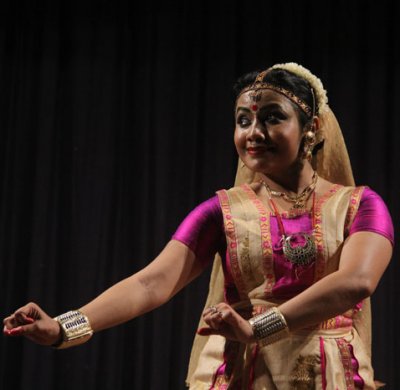 Anwesa Mahanta 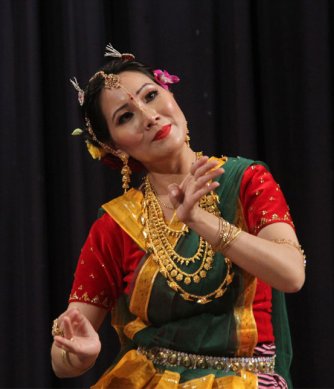 Lilabati Devi From Imphal, Lilabati brought two numbers of traditional Manipuri. She has an attractive stage presence and sound training in Manipuri from Jawaharlal Nehru Manipuri Dance Academy. Trained by traditional gurus in Rasalila and other forms, Lilabati with her sister Vedbati are the only two exceptions, who have studied Bharatanatyam at Kalakshetra in Chennai. But Lilabati after her Ph D from University of Hyderabad is teaching Manipuri at Manipur University, and continues to give performances. The opening number was Krishnarupa varnana, describing the beauty of Krishna, to tanchap tala and displayed various basic elements of Manipuri dance, with bhramaris and petal soft footwork, gentle movements which set Manipuri form from other dance styles. With attractive costumes and hand ornaments as aharya, Lilabati performed with natural grace. It was in Gita Govinda ashtapadi "Haririha mugdhavadhu nikare" set to Amritavarshini raga, taught to her by late Guru Babusingh, that Lilabati in faster tempo displayed her command over nritta and angikabhinaya. The verses are alternately repeated like mukhbol, kavits in Kathak and enhance the impact of Krishna's dancing with other gopis. It lent charm to the presentation. Since there is less of mukhajabhinaya (facial expressions), the entire body speaks as angikabhinaya. Lilabati performed it maintaining the spirit of the Manipuri form. It was interesting to watch her. Parul as a curator of the festival had done a good job of bringing young generation of dancers from North East. Similarly, she had invited P. Sunil Kumar, a trained young Kathakali dancer from Tripunitara, Kerala, and his French wife Paris Lakshmi, to present a dance number together - Sunil Kumar performing Kathakali in full paccha (green) makeup as Krishna and Paris Lakshmi in Bharatanatyam as Radha /Gopi. Even when the music posed problem, as Sopanam music is for Kathakali and Carnatic music for Bharatanatyam, somehow the arrangement of dancing together, one in Kathakali and other in Bharatanatyam, engaged the attention of audience from the word go. It was obvious that as a husband and wife team, with sound training in Kathakali and Bharatanatyam respectively, they had chosen common theme that would appeal to the audience. In particular, the theme of Gitopadesha worked well with audience, as they could follow the story along with recitation of "Yada Yada hi Dharmasya glanir bhavati Bharata," from Gita, Lakshmi impersonating Arjuna, Sunil Kumar as Krishna driving the chariot, Arjuna dropping his Gandiva and refusing to fight, Krishna displaying his Viswarupa, and Arjuna listening to Krishna's 'Karmanyeva adhikaraste' advice, lifting Gandiva and shooting arrows - all worked well in terms of dramatic presentation, and audience was least bothered about two different styles. Another number to the song of Swati Tirunal in Hindi, "Aaj aye Shyam Mohan Rasamandal khelane," the duo danced with aplomb and in a pleasant mood. For purists it posed problems. Two different music traditions do not coalesce and is a major hurdle the dancers need to cross. Senior music critic Manjari Sinha raised this point next morning in her presentation in the seminar, explaining how each music is autonomous and independent. And therefore our each dance form has special music, which needs to be maintained. Point made. At the same time one cannot ignore the fact that the experiment succeeded in appealing to large mass of audience in spite of this reservation. Kathakali dance drama form is facing a problem in the state of its origin in Kerala as audiences are dwindling. There this French dancer who has also studied Kathakali but is specializing in Bharatanatyam, has managed to work out a suite of dance which has found favour with audiences. 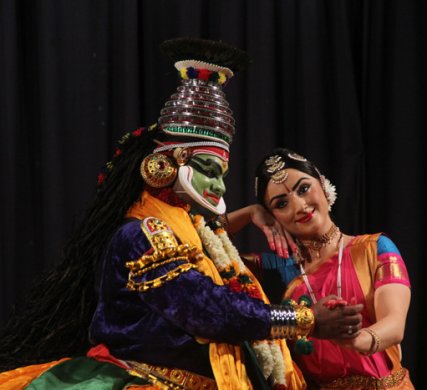 P Sunil Kumar & Paris Lakshmi 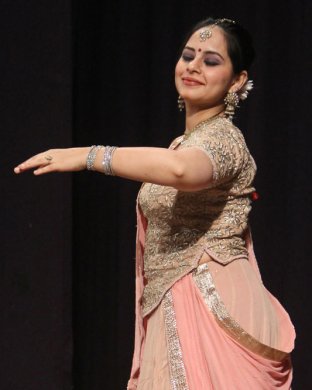 Rupanshi Kashyap The finale was Kathak by Kumudini Lakhia's disciple Rupanshi Kashyap to live music with ace tablist Joby Joy from Kerala, Ramesh Vanzara on sarangi and Rohit Gangani on vocal and harmonium. Rupanshi performed with confidence and zest. She and tablist were on the same wave length with the result that there were no hitches in continuity of performance, as Rupanshi and tablist could continue performing minus any discordant note. Manjari Sinha requested that the mikes be arranged in a manner so that the music does not drown Rupanshi's padhant, recitation. Rupanshi had recently performed for Raza Foundation in Delhi. Therefore one had an idea of her taiyyari under Kumudini Lakhia. To the credit of Kumudini and Rupanshi it must be said that the guru has seen the potential of the shishya and trained her in a manner that she stands in her own individual strengths and merits highlighting her own gifts. She is not a clone of her guru nor is influenced by her other contemporary dancers, and colleagues. That she enjoyed dancing was obvious from the word go. Her nritta has refinement and sophistication, the hallmark of Kumudini's style. The movements are broad, graceful; she covers stage space with ease and concludes movements pat on the sam. Any Kathak dancer has to have that mastery. But in case of Rupanshi it looks effortless and natural. Variations of dha taka thunga, other mnemonic syllables of intra-forms, tode, tukde, parans and upaj ang, verifying tala, with tihais, jugalbandi like rapport with tablist, Rupanshi proved that she has acquired sufficient mastery over the form. Performing Ganesh stuti to Dipachandi tala, using prayer with Rajasthani libretto for Bhavani, to the prayer researched and worked out by Rohit Gangani, Rupanshi brought certain freshness to its rendering. Her sparkling and scintillating Kathak brought down the house. Here is a dancer worth watching. She has shown her potential and is bound to go places. On next evening, excerpt from Anjali Merh's choreography of Chandramaulishwara Kuravanji was presented. In 1977, when I had completed my Ph. D under Anjali on Bhagavata Mela Natak, Kuchipudi and Kuravanji dance-dramas, I had requested Anjali with her sound training under Rukmini Devi at Kalakshetra and her competence in both Hindustani and Carnatic music, to compose Kuravanji dedicated to Somnath, Lord Shiva, in Gujarati. Anjali worked towards it and created first of its kind in Gujarati Kuravanji dance-drama. The opening was with a Kavuthvam and set to Yaman raga. The four dancers, Divya Patel, Ami Pandya, Mina Dodeja and Rohini Thakar danced with commendable perfection. Parul's reconstruction of the original was presented with screening of original video on the background, and the synchronization was quite fascinating. That I saw it after an interval of some three decades brought happy memories of its presentation at Bharatiya Vidya Bhavan in Mumbai in 1977. It was wonderful to revisit Anjali's choreography. Parul has often revived it and it has been also performed at Somnath Temple. It was an apt tribute to Anjali Merh. When I was doing my Ph. D in Baroda, both Anjali and I used to interact together for creative work. For the new younger generation it is absolutely important to acquaint themselves with work of the pioneer. 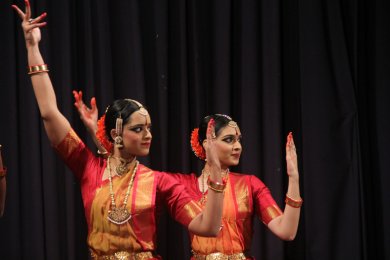 Radhika Kathal and Madhura Bhrushundi
Geeta Chandran's three disciples from Delhi presented three Bharatanatyam numbers, choreographed by Geeta under the dance title Swara Raga Sudha. Amrithasruthi Radhakrishnan, Radhika Kathal and Madhura Bhrushundi are well trained young dancers with more than ten years of experience and exposure having performed solo as well as in group along with Geeta Chandran. In her choreographer's note Geeta mentions that the creative exploration in classical Bharatanatyam plots the cadence and flow between music/sound and body/ dance. It constructs a stunning hyphen between the breath of both disciplines -music and dance. It is an abstract discovery of movement, there is sequenced exploration, bringing to the dance the classical training and understanding of movement. I visualize that dancers' bodies veritably must melt into the raga's notes. This heightened understanding of Geeta is further complimented by three dancers giving thought concept which is 'abstract', a 'concrete' shape, the way three of them hold their arms and palms, standing rock steady on one leg, other bending backwards in vrischika karana, a scorpio bend. Their horizontal arm movements, creating various geometrical patterns are a visual treat, along with mnemonic syllables, jathis and enchanting music. These explorations set apart Geeta's choreographic vision that transforms in her disciples' dancing. Geeta has reconstructed Telugu varnam "Vanajakshi for three dancers enabling them to impersonate different roles in a seamless manner. Krishna's lotus eyes find felicitous expression with hastas that spring with ease, eyes that sparkle, the river Yamuna's waters flow, and when the dramatic episode of subjugating poisonous serpent Kaliya, the game of playing with ball, its falling deep in waters of Yamuna, Krishna's jumping into it to retrieve it, and dancing on the hood of Kaliya, et al take place before our eyes like watching a painting. Geeta's sense of choreographing it for three dancers is impressive. The finale Tillana was like a flash of lightning. The three dancers performed it with uniform movements, symmetrical and scintillating. There was that joyous abandon in periya adavus, covering the stage. No wonder they received standing ovation from the audience who sat through, though it was rather late when the programme concluded. The symposium held in the morning dealt with literature and poetry. From Ahmedabad, Sonal Majumdar, born as Nagar and descendent of poet Narasimha Mehta, expressed how she wanted to dwell upon the subtle nuances and spoke about the poems of Narasimha Mehta. She told an anecdote about a devotee's express desire to see Raslila of Krishna, holding torch in his hand, and he was so absorbed watching it that his arm got burnt but he did not realize it. She spoke of Narasimha Mehta's well known poem "Jala Kamal chhandi jane Bala," the wives of Kaliya serpent praying to Krishna and not to wake up their Lord, as performed in Bharatanatyam, and thereby reaching a large audience. Also interpreting the meaning of stanzas, environment, the population of Nagaloka, tribals, the Ahirs, suggesting how they were being subjugated and the injustice done to them. Taking myth and interpreting it with contemporary references and situations how one can extend the horizons of literature and dance with configuration of two disciplines was an interesting point she made. How she had choreographed them in Bharatanatyam - of particular interest was Narasimha Mehta's poem "Kunvarbai nu mameru." When his daughter gets married, the bridegroom's people make demands of what they want from the bride. In order to embarrass Kunvarbai, the bride, they make demands which Kunvarbai's father cannot fulfill. Then Lord Krishna comes to his rescue taking role of a wealthy merchant Shamal Shah and saves the father of the bride and the bride from humiliation. It also resonated with cotemporary social issues though it was not with that intention the choreographer had taken the poem. It was mainly used to make audience understand the content in Gujarati with use of appropriate music and Bharatanatyam style. From Ahmedabad, Suprava Mishra spoke of how settling in Gujarat after marriage, as an Odiya performing Odissi dance, she selected the Gujarati translation of renowned Gyanpith awardee Odiya poet Ramakant Rath's poem Radha and set it in Odissi technique. Ramakant Rath's Radha is not a cry baby, but an independent woman, deeply in love with Krishna, at the same time not shedding tears when in separation. This depiction of Radha as a nayika is very refreshing. She also had set Narasimha Mehta's "Vaishnavajan" poem, popular as Gandhiji loved it, as a prayer. Using it as a suite of Odissi repertoire from Mangalacharan to Moksha, she used different stanzas for different items of Odissi. In item of Pallavi, taking inspiration from the sculptures of stepwell known as Rani ki Vav, using the sculptures of dancing damsels of Shilpaprakash text, she employed those motifs. Barring two incarnations which are not found in the stepwell, she also used as specially choreographed Dashavatara item. It was heartening to see her initiative to use various arts besides literature in her chosen medium of Odissi. Manjari Patwardhan from Rajkot, a disciple of Rajendra Gangani, presented celebrated tablist Kishan Maharaj's Ganesh Paran. Fond of literature, though Maharashtrian by birth, she relished Gujarati poems. With help of her friend Indu Joshi, a poetess in Gujarati, she got in touch with Shitanshu Yashashchandra and undertook to choreograph in Kathak style, Narasimha Mehta's long akhyan "Kunvarbai nu mameru." Setting it in Kathak using gat bhav, palta, tatkar, bhramari and other intra forms of Kathak, she showed how such a theme can be used for depicting such theme in dance. I mentioned Kumudini Lakhia's choreography of Okha Haran which was performed for her institution Kadamb which had 22 shows. Poet Rajendra Shukla recalled how Gujarati text was a big success. Shitanshu suggested that this confluence of two arts be called Kala Sakhya, friendship between two arts. Hasubhai Yagnik gave excellent examples of various arts, the basic rhythm, laya, and the importance of music, six plastic arts, relevance of sculpture, painting, architecture, literature, dance and their interrelationship. 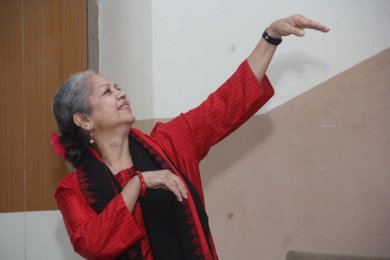 Parul Shah Purvi Sheth from Rajkot spoke about themes on Mahavir, Jain Tirthankar who could not be shown in dance as Jain icons could not be shown by human beings. Her attempts to present Kalidasa's Ritusamhara in six ragas and variety of colours for costumes to suggest the seasons were noteworthy. Inviting Krishna to come and protect people from terrorism as metaphor were interesting issues and Bharatanatyam for songs which have popular appeal. She explored songs about Krishna's pranks and Gopi complaining to Yashoda who protects Krishna saying that when he has in his own home enough milk and butter, why should he steal from Gopi's home? The naughty Krishna and Yashoda's defense were shown in Bharatanatyam to Gujarati song. Parul demonstrated on the spot to Aruna Choksi's selected poems among one on married daughter taking leave of parents was very moving. It is a marriage song "Parma etle pyara ladi chaalo aapane gher re" - O dear girl, now that you are married leave for in-law's home. It is a well known song and brings tears to the eyes of all who listen to it when a young girl leaves for her husband's home. Divya Patel and Mina Dodeja's duet about two nayikas on shringara theme and poem by Ramesh Parekh when the devotee asks for little water God gives the entire ocean was noteworthy for simile and execution in tala and popular tune in Bharatanatyam. Poet Jaydev Shukla's intervention about diminished discourse on criticism in dance and why new innovations are not seen was timely and relevant. He quoted Ashok Vajpeyi's observations that there is less dialogue between painters, sculptors, writers, poets and dancers, and we notice fewer innovations in dance. I mentioned that it is only true in part because discussion on this topic also takes place. Because of mediocrity in dance by a large number of dancers, the excellence is seen less and that results in such observation. Ultimately it is excellence which matters in classical arts. It was important to have this session as it brought few leading poets of Gujarati literature and dancers together exploring poems to make abhinaya and art of dance more accessible to common audience. Next day, music critic Manjari Sinha from Delhi, explained the importance of music in dance. Why these two arts have to move with complete coordination to enhance the beauty of dance with exquisite music. Manjari gave example of how a gifted exponent like Birju Maharaj choreographs a special number using solfa syllables and matches it with select ankle bells and creates unusual experience. She laid emphasis on sound knowledge of music on part of dancers. She mentioned about Kathakali and Bhartanatyam duet with different music, not going hand in hand and though it had popular appeal, for rasikas it was not a happy experiment. She also admired Rupanshi Kashyap's rapport with tablist and the resultant aesthetic experience. V.R. Devika from Chennai, a Ph. D on works and thoughts of Gandhiji, and a Bharatanatyam dancer expert in storytelling and also authority on folk dance forms of Tamil Nadu, spoke on Dr. Muthulakshmi Reddy, a revolutionary social worker, educated woman from Devadasi community, who worked for the rights and upliftment of Devadasi community when there was opposition for Bharatanatyam as a dance form in early thirties. She established a home for destitute women from Devadasi community. There was a historic battle between her and E. Krishna Iyer who rescued Bharatanatyam and succeeded in establishing it as an art form in society. It was at the same time in 1936 when Rukmini Devi established Kalakshetra to teach Bharatanatyam, Dr. Muthulakshmi was opposed to practice of Bharatanatyam in temple. The Bill for abolition of dance in temples by Devadasis was introduced in Parliament and Muthulakshmi was in favour of discontinuation of temple dancing but wanted to assist community deprived of their art to have enough economic support. Hers is an amazing story. Devika is working on her life and is interviewing Muthulakshmi's contemporaries and associates to assess her work in proper perspective. Devika was also director of education for schools and succeeded in producing films on Devarattam dance form and various other forms including Therukoothu and created awareness among students of the living traditions of folk dances. The videos she screened were quite an eye opener. The huge image of Duryodhana almost like Gulliver, taken to Gods, and asked forgiveness for killing him, but maintaining that he was a good king. The visit to Draupadi's temple and begging her forgiveness et al were extremely interesting from point of storytelling. Given more time, Devika could have shared a lot of her work which is extremely interesting. This intervention on her part proved of a lot of interest for the audience. I spoke on Chandralekha's innovative works screening 1985 Tana Bana television production in which she speaks of how she started looking at the basics of Bharatanatyam and how to resolve contemporary issues. Her use of Kalaripayattu, Yoga and other physical disciplines and several productions different from mythological themes are now part of New Directions in Indian dance. The issues which bothered Chandralekha are issues which young generation of Bharatanatyam and classical dancers are facing and have to find their own solutions. She always emphasized the need for dialogue between different arts. She was not in favour of only presenting mythological themes and looked for different themes in dance which resonate with contemporary issues. It is important to revisit Chandralekha's work for young generation. She was indeed a very gifted unusual dancer and lived her life on her own terms. A thinker with imaginative approach looking at dance, she has left enough impact on genre of contemporary dance in India. This year, Nritya Parva was supported by the Faculty of Performing Arts and the Institute of Leadership and Governance, both of the Maharaja Sayajirao University of Baroda. The morning session of Feb 9 was in collaboration with Forum on Contemporary thought. Gujarati Sahitya Parishad and Balawant Parekh Center were collaborators for Feb 10. Nritya Parva 2018 managed to enlist support of Gujarati poets and also engaged young dancers in discussions and succeeded in exposing them to young professional dancers of different styles. There were problems of time management for evening recitals. Those can be solved with proper planning in coming years.  Dr. Sunil Kothari is a dance historian, scholar, author and critic, Padma Shri awardee and fellow, Sangeet Natak Akademi. Dance Critics' Association, New York, has honoured him with Lifetime Achievement award. Post your comments Please provide your name and email id when you use the Anonymous profile in the blog to post a comment. All appropriate comments posted with name & email id in the blog will also be featured in the site. |